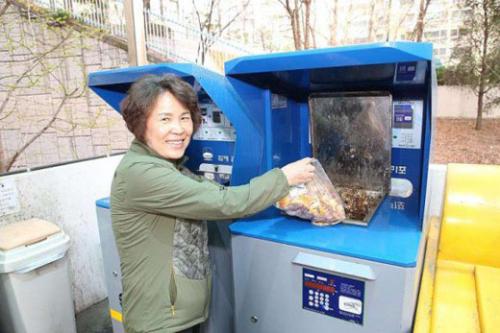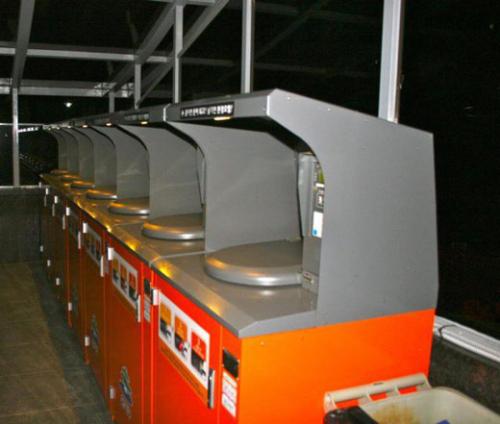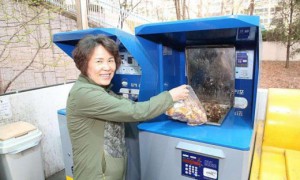Unique 'Pay as You Trash' system helps South Korea cut food waste

In a bid to control the nation's growing problem with food wastage, the South Korean government has started a unique initiative – "Pay as You Trash". Residents are required to separate their food waste from the rest of their trash and dump it separately in a centralised bin. And in order to access the bin, they actually need to pay by the kilo!
为控制国内不断加重的食物浪费问题,韩国政府推出了一项特别举措——“为食物垃圾买单”。民众需要单独归类食物垃圾并倾倒在集中垃圾箱里。但要想打开垃圾箱,他们得按重量交费!
As of now, the South Korean government has three methods in place to charge citizens for the food thrown away. One is through an RFID (Radio Frequency Identification) card – when users tap this card – embedded with their personal tag – over a specially designed food waste bin, the lid will open, allowing them to dump their waste. This waste is automatically weighed and recorded in the user's account. The user needs to settle this bill on a monthly basis. Each RFID bin costs 1.7 million won ($1,500) and can cater to 60 households.
截至目前,韩国政府已推出三种垃圾收费方式。第一种,通过无线射频识别(RFID)卡缴费——当使用者将载有个人信息的识别卡置于专用食物垃圾箱上方时,箱盖会感应开启,此时使用者可将垃圾投入箱中。用户倒入的垃圾将被自动称量并记录在账号中,并按月结清费用。每个RFID垃圾箱价值170万韩元(约合1500美元),可供60户家庭使用。
The second billing method is through pre-paid garbage bags. These specially designed bags are priced based on volume. For instance, in Seoul, a 10-liter garbage bag costs around 190 won (less than $1). There's also a bar code management system in place, in which residents deposit food waste directly into composting bins and pay for it by purchasing bar code stickers attached to the bin.
第二种,通过预付费垃圾袋缴费。这种特别设计的垃圾袋按容量计价。如在首尔,一个容量10公升的垃圾袋要价约190韩元(不到1美元)。最后一种方式是条形码管理系统。民众可将食物垃圾直接倒入未分类垃圾箱中,再扫码购买垃圾箱上附着的条形码贴纸即可。

Nearly every residential complex in the nation is equipped one of these three payment systems. Even before the pay-by-weight system was introduced, South Koreans were still being charged for food waste – the cost was simply divided equally among the tenants of each apartment block. The new system is not only fair, but is also designed to make consumers really feel the pinch of excessive waste. The more food they toss out, the more they end up paying.
在韩国,几乎每个居民区都配备了以上三种方式之一的支付系统。其实在引入按重计费系统之前,韩国就已经开始对食物残渣进行收费——费用只是单纯平摊在每个小区的用户上。新系统不仅强调公平,还使消费者真正意识到过度浪费的不良影响。食物浪费得越多,费用缴纳得越多。
And it's working – residents like Seoul housewife Ms. Kwan are now adopting innovative methods to avoid food waste. She makes sure to strain all the liquid out of leftover food before throwing it away. She also separates fresh produce and other food items into smaller portions so that only the required amount of ingredients are used up per meal. While prepping vegetables, she tries to make use of as much as the edible parts as possible, in an effort to minimize waste.
这项举措正在奏效——现在,像家住首尔的家庭主妇关女士等居民都采取了创新方法防止食物浪费。在将食物残渣扔进垃圾袋前,关女士一定会将其中的水分沥干,她还会将食材分成若干小份,确保每餐只吃需要的份量并做到光盘。此外,在准备蔬菜时,关女士会尽可能留下可食用的部分,这样也减少了浪费。
"Because I'm worried about the disposal fees, I'm more careful about food waste now," she said. "Our food waste has become much less than before."
她表示:“我这么做是因为担心垃圾费,现在我对食物垃圾更上心了,我们的食物垃圾比以前少很多。”
"People used to buy a lot of food and throw away leftovers without much care," said Yu Gwang Mo, a government official from Seoul's Mapo district. "After realising they have to pay for how much they throw, they have started to control their food purchase."
俞光谟是首尔麻浦区的一位政府官员,他表示:“人们习惯购买许多食物,肆意浪费剩饭剩菜。知道扔多少垃圾花多少钱以后,他们开始控制食物消费。”
"I think it's a good idea," added Mapo housewife Cho Sung Ja, "because people started to pay more attention to how much trash they throw and there's now less food waste and the trash bin area has become cleaner too."
麻浦区一位家庭主妇赵成雅也补充道:“我认为这项措施很好。因为人们开始注意自己丢了多少垃圾,食物垃圾变少了,垃圾箱都变得更干净了。”

Restaurants and other food-based businesses are also actively trying to reduce their pay-by-weight disposal bill, by their own food waste processor – a machine that converts food scraps into dried powder that can be used as fertilizer. Some restaurants are actively trying to reduce the amount of food they waste by donating leftovers to the poor and hungry.
餐馆和其他食品行业也积极减少按重计价的账单。他们把食物垃圾放入处理机中,将这些残羹剩菜转化为脱水粉末用作肥料。一些餐馆还向贫穷饥饿者提供剩菜剩饭以减少食物浪费。
According to official surveys, food waste in South Korea accounts for 28 percent of total waste by volume. 30 percent of this comes from leftovers, while 5 percent of the wasted food is thrown away uneaten. In smaller restaurants, leftovers account for 68 percent of all food wasted. Disposing this kind of waste costs the government a whopping 800 billion won per year. Through various initiatives such as "Pay as You Trash", the government has managed to cut food waste from 5.1 million tons in 2008 to 4.82 million tons in 2014.
根据官方调查显示,食物垃圾占到韩国垃圾总量的28%。其中30%是剩饭剩菜,5%是原封未动的食品。在小餐馆,剩饭剩菜占到了所有食物垃圾的68%。韩国政府每年要花费8000亿韩元(合人民币45.6亿元)处理这类垃圾。通过“为食物垃圾买单”等各类举措,政府已成功将食物垃圾从2008年的510万吨降到2014年的482万吨。
Vocabulary
cater to: 为……服务